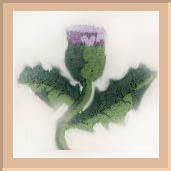Many locations in America were nostalgically named after the places the Scottish immigrants had left behind. There are eight Aberdeens, eight Edinburghs, seven Glasgows and eight places, simply known as Scotland, in the United States today.
Before the Declaration of Arbroath, Scotland was organised under a clan system. Many members of the great clans travelled to the New World and named the places in which they settled in honour of their clan names. Today there are areas named Campbell, Cameron, Crawford and Douglas, throughout the US.
The common Scottish surname suffix Mac or Mc can be seen at the start of many area names; in North Carolina alone there are 130 such places.
There are many societies in America, such as the St Andrew's Society - named after the patron saint of Scotland, that attempt to retain aspects of Scottish culture and heritage.
Clubs and societies celebrating Scottish ancestry were established in the 18th Century to assist struggling Scots in the new land.
Throughout America and Canada there are over 300 St Andrew's Societies, Caledonian Clubs and other Scottish societies.
Popular Scottish sport, such as golf and curling, were imported to America by the Scottish immigrants.
Modern American track and field events originated from massive Scottish athletic tournaments.
Whisky is the national drink of Scotland and none can surpass it for quality or taste, which is why real connoisseurs will always insist upon it.
Central to life at the time of mass immigration to the United States was the Kirk (Scottish word for the church). When the Scots moved to America, they brought their religion of Presbyterianism with them. Today the Presbyterian Church has over 3million members and, is one of the largest mainstream Protestant churches in the US.
In 1925 the Presbyterian Church of Canada formed, with two other Protestant churches, the United Church of Canada. In 1990 there were over 850,000 members.
The Scots were a valuable addition to a developing world. Their past experience of working in the harsh conditions of rural Scotland, combined with their hard-working Presbyterian upbringing, made them an ideal people to help build America in its formative years.
There were three distinctive groups of peoples of Scottish ancestry that emigrated to America: the Lowland Scots, the Highland Scots and the Scotch-Irish.
Religious persecution in Scotland prompted many to leave their homeland in the early 17th Century. Early settlements were established by these colonists in East Jersey in 1683 (now eastern and northern Jersey) and in South Carolina in 1698. Both these early colonies failed.
Scotland's history has been a tempestuous one, fraught with tension between England and Scotland. Between 1715 and 1745, more than 1,400 defeated Jacobite rebels were banished from their homeland and sent to America for their "crimes".
After the 1707 Union of the Parliaments, trade between Scotland and America dramatically increased. Merchants began to take advantage of the huge opportunities available in the New World, especially in the tobacco trade. Emigration by this group was mostly to Virginia where the tobacco trade was strongest.
The Scottish emigrants of the 18th Century were an educated group due to the Scottish Reformation, which had stressed the need for education, allowing every Scot the ability to read the bible.
Education has always played an important part in Scottish society, and these Scots played a crucial role in the early development of the New World. Most headmasters of the schools in the new colonies south of New York were Scottish or of Scottish ancestry. These establishments were fundamental in the education of America's future leaders; both Thomas Jefferson's and John Rutledge's tutors were Scottish immigrants.
Scots arriving in the New World soon established universities, colleges and other educational establishments such as Princeton University, which was initially named the College of New Jersey, when founded in 1746.
During the mid-17th Century Scottish medical establishments were second to none in the fields of education and science. Many recipients of these teachings came to America, where their influence can be seen to this day.
Many Americans travelled to Scotland to gain an education in medicine. In 1775 there were 3,500 people practising medicine in the US, though only 350 or 400 actually held degrees. Most of those holding degrees had been educated in Scotland.
The Scots greatest contribution to American medicine was the belief that it was not simply the body but the mind that must be healed. Drawing upon their knowledge of philosophy and the humanities they expounded the need to be humane when treating patients.
Scots were crucial in establishing separate medical teaching institutions; previously all medical education had been taught within the confines of medical establishments.
Scots have played their part in the political history of the United States. More than one hundred governors of pre-Revolutionary colonies and post Revolutionary States were of Scottish birth or descent.
Also:
35 Supreme Justices have been Scots
Of 73 great Americans in the Hall of Fame, 25 were of Scottish bloodline
Nearly half of the secretaries of the U.S. Treasury and one third of the Secretaries of State have been of Scottish origin
Of the 56 signatories of the Declaration of Independence, 9 were direct descendents of Scottish bloodlines
9 out of 13 Governors of the newly created United States were Scots or of Scottish bloodline
Of 50 Judges of the Supreme Court from 1759 ~ 1882, 15 of them were of Scottish Ancestry
James Pollock (1810-90), responsible for putting "In God We Trust" on the U. S. coinage, was of Scottish descent






